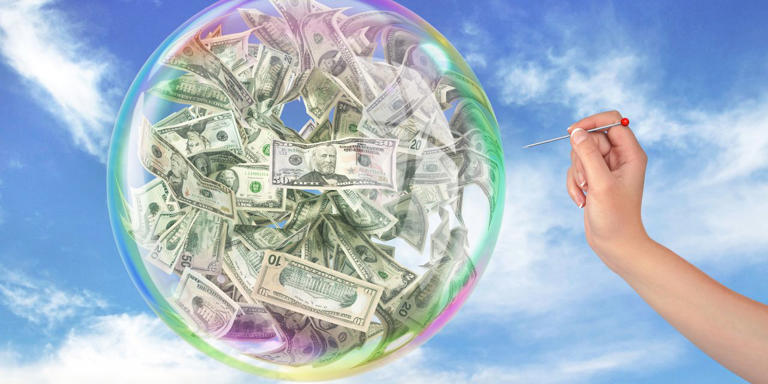The Nasdaq’s troubles might only be beginning, with technology stocks potentially heading for a crash reminiscent of the prolonged bear market that followed the dot-com bubble burst. This perspective comes from Société Générale’s Albert Edwards, who voiced his concerns in a Thursday client note. Edwards, known for his often bearish views, scrutinized the current bullish sentiment driving the artificial intelligence (AI) boom, which has been a significant factor in pushing major U.S. stock indexes to record highs.
Edwards began by questioning the assumption that the market can smoothly transition away from Big-Tech leadership without provoking a broader downturn in the S&P 500. He argued that historical data does not support this optimistic view. Historically, highly concentrated markets have frequently preceded major crashes, such as those before the 2007-2008 global financial crisis and the 2022 bear market. Edwards sees no reason why the current situation would deviate from this pattern.
Proponents of the current market rally often point to the lofty valuations of companies like Nvidia Corp. and other megacap stocks, suggesting that these valuations are justified by their rapid earnings growth. They claim that this growth differentiates the current AI-driven market from the dot-com bubble of the late 1990s. However, Edwards offers a counterargument. He recalls that during the dot-com era, substantial investments in networking equipment temporarily made Cisco Systems the world’s most valuable publicly traded company. Yet, following this peak, Cisco’s shares suffered a dramatic decline.
In the late 1990s, Cisco experienced rapid earnings growth, similar to what Nvidia is seeing today. Despite this, Cisco’s valuation surged beyond sustainable limits, fueled by excessive optimism from Wall Street. Edwards emphasized that during the 1990s, the Nasdaq bubble was partly driven by physical investments leading to excess capacity. This speculative spending did boost sector earnings but never sufficiently to justify the inflated valuations.
Edwards pointed out that there are signs of a similar pattern emerging today. Since the launch of ChatGPT in November 2022, earnings-per-share growth in the tech sector has been robust. However, Edwards noted that expectations have started to outpace actual company performance, similar to the late 1990s dot-com bubble inflation. He observed that Wall Street analysts have already stopped pushing these estimates higher. This stagnation alone could trigger a decline in technology stocks, given the close correlation between analyst optimism and the short-term performance of the Nasdaq-100.
Edwards also suggested that Wall Street economists might be underestimating the likelihood of the U.S. economy sliding into a recession. The Nasdaq Composite fell by 1.1% on Thursday afternoon, potentially ending a six-week winning streak and marking its largest weekly drop since April 12, according to FactSet data.
The so-called Magnificent Seven, a group of megacap stocks anticipated to benefit from AI advancements, experienced mixed trading on Thursday. Nvidia, Meta Platforms Inc., and Tesla Inc. saw gains, while Microsoft Corp., Amazon.com Inc., Alphabet Inc., and Apple Inc. traded lower. This divergence reflects the market’s uncertainty and the varying impacts of speculative investments across different sectors.
In other market movements, shares of Eli Lilly & Co. declined after Swiss pharmaceutical company Roche announced positive results from an early-stage study for a weight-loss drug. Eli Lilly had seen significant gains this year due to high demand for its GLP-1 drugs, which are used for weight loss.
The broader market faced declines as well, with the S&P 500 down 1.1% and the Dow Jones Industrial Average falling 1.4%. Quincy Krosby, chief global strategist at LPL Financial, noted that political uncertainty is adding to the market’s volatility. She pointed out that the market is entering a seasonally volatile period, further exacerbating the selloff.
Krosby also mentioned that the selloff in the Russell 2000 is leading the indexes lower as the Cboe Volatility Index, Wall Street’s “fear gauge,” climbs higher. There are growing concerns that the Federal Reserve may need to ease interest rates due to a softening economy, particularly in the labor market, rather than because inflation is edging lower.
Kevin Gordon, a senior investment strategist at Charles Schwab & Co., cautioned investors against creating a “Biden basket” or “Trump basket” based on who might occupy the White House. He highlighted that the energy sector, which theoretically could have suffered under Biden’s green-energy agenda, has actually outperformed, with the S&P 500 energy sector advancing roughly 116% since Biden’s 2021 inauguration. This outperformance contrasts with the energy sector’s struggles under Trump, despite his pro-oil drilling stance.
In summary, the current market situation is fraught with uncertainty and risk. The parallels to past market bubbles, the potential for a tech sector correction, and the broader economic concerns all contribute to a challenging environment for investors. The mixed performance of key stocks and sectors underscores the complexity of the market dynamics at play. Investors should remain cautious and consider the historical precedents and current economic signals when making investment decisions.
